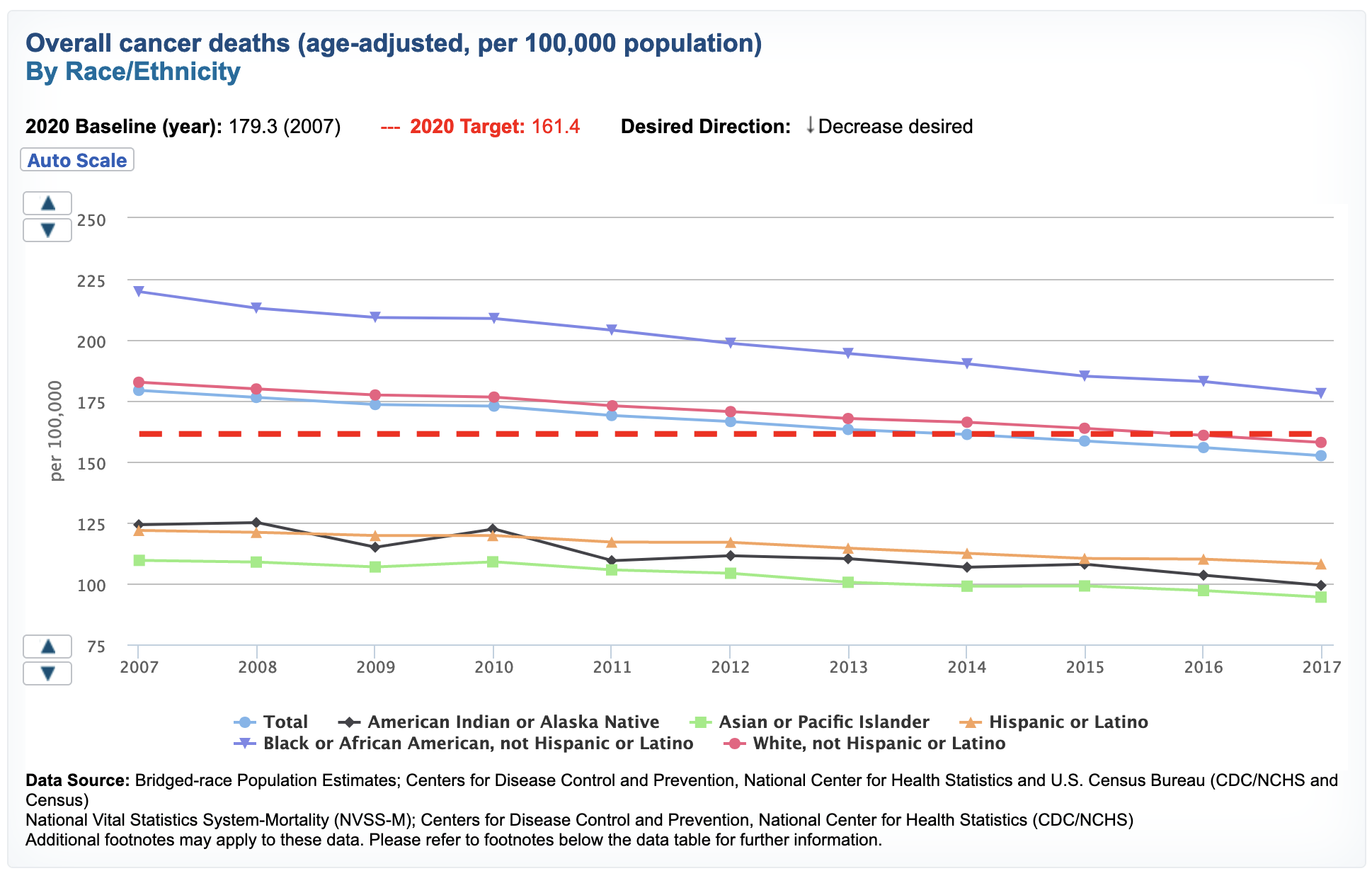Even in modern times, patients face health disparities in the everyday practice of healthcare facilities. Healthy People 2020 (n.d.) defines this term: “health disparity is a particular type of health difference that is closely linked with social, economic, and/or environmental disadvantage” (para 5). In other words, it means a higher burden of illness based on sex, gender, race, and other identities. The typical health disparity in the US is the over-presence of the African American community in charts on cancer and other diseases (Figure 1). The same figures are identical for diabetes cases, deaths from HIV infection, and many other illnesses (Shick et al., 2019). The main purpose of nursing concerning this issue is to maximize awareness of disparities and attain better knowledge of effective practices to eradicate inequality.
Social Justice in Nursing Practice
Understanding the essentials of social justice is an important part of nursing practice. The main reason is that it helps increase the well-being of the whole population because marginalized groups constitute the biggest proportion of health problems. In basic terms, social justice in healthcare means equal treatment for everyone. The main premise of this paper is that some shifts in nurses’ attitudes may be a great trigger for change. Thus, social justice can be achieved by getting acquainted with patients’ first-hand stories about their experience of health disparities and social determinants. For example, there are many handbooks such as “Health disparities: Weaving a new understanding through case narratives” edited by Perzynski et al. (2019). Here African Americans, members of sexual minorities, and other systematically discriminated groups are describing their concerns and doubts about the functioning of the healthcare system (Perzynski et al., 2019). Such detailed knowledge will allow nurses to adjust their practice to the needs of special groups.
Essentials of Social Justice in Healthcare
Social Justice and Diversity
Although people often use the notions of diversity and social justice interchangeably, they are slightly different in meaning analytically. Former means differences based on cultural traditions, experiences, and overall ways of seeing life (Dukes, 2021). Latter refers to building human relations on the principles of equality and tolerance with a strong emphasis on eliminating hierarchies (Dukes, 2021). Thus, the appreciation of diversity is included in the broad field of social justice. It is obvious that conditions for nurses will worsen if the staff cannot ensure the functioning of the social justice policy.
Family- and Patient-Centered Care
Family- and patient-centered care is used as a model for providing treatment across various healthcare settings. The main idea is that it requires mutual power-sharing relationships between patients, family, and caregivers and more active involvement of patients in the care process (Park et al., 2018). The types of intervention that are characteristic of patient- and family-centered care are physical support, empowerment, and patient information (Park et al., 2018). Although there could be some disagreements between the stakeholders of this cooperation, it is regarded as a high-quality approach (Park et al., 2018). In everyday practice, there were instances when sexual minority groups did not receive support from their families because of parents’ prejudice about their children. It is a clear sign of health disparities.
Barriers to Providing Social Justice Care
The help of nurses will be of poor quality if there is no knowledge of cultural competencies among them. Cultural competencies mean the set of skills and knowledge required to work with minority groups. Sharifi et al. (2019) emphasize the importance of experience, indicating that cultural competencies are the “ongoing process through which health care providers continuously attempt to acquire the ability to work in different cultural societies” (p. 5). For example, barriers may arise if none of the nurses speak Spanish, while a great proportion of the US population is Hispanic. Another example is that nurses may not have experience working with people of particular ethnicities and religions, which can lead to misunderstandings. Due to the inability to provide the same treatment as for English-speaking white people, the disparities in health status can be huge and affect the well-being of the entire community.
Conclusion and Recommendations
To sum up, this paper covered the important topic of health disparities in relation to nursing practice. The problem that requires immediate action is that there are huge disparities between the health status of the white and minority population. The main focus here was made on eliminating prejudice at healthcare facilities. After the brief discussion of major concepts and barriers to providing qualitative care, some recommendations may be laid out. Firstly, one promotion activity is hiring Spanish-speaking staff to target the Hispanic community. It is an essential part of every scholarship on cultural competencies to combat health disparities. Another group that requires special attention is religious and ethnic minorities. It is a common issue when nurses ask questions and say something that is considered impolite in different cultures or explain the treatment process in complicated ways. It may be solved by providing special courses and lectures to nurses that will professionally explain how to build connections with minority groups.
References
Dukes, K. N. (2021). Free speech, diversity and social justice dialogue. Nature Human Behaviour, 5(12), 1592-1592.
Healthy People 2020 (n.d.). Disparities. Web.
Perzynski, A., Shick, S., & Adebambo, I. (Eds.). (2019). Health disparities: Weaving a new understanding through case narratives. Springer International Publishing.
San Diego Foundation. (2016). What is social justice?
Sharifi, N., Adib-Hajbaghery, M., & Najafi, M. (2019). Cultural competence in nursing: A concept analysis. International Journal of Nursing Studies, 99, 1-8.
Shick, P., Adebambo, I., Perzynski, A. (2019). Health disparities and social determinants of health. In A. Perzynski, S. Shick & I. Adebambo (Eds.), Health disparities: Weaving a new understanding through case narratives (pp. 7-15). Springer International Publishing.
Appendix A
